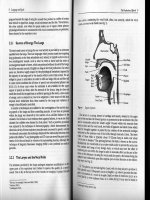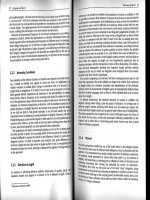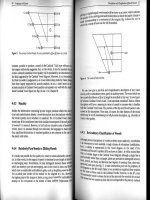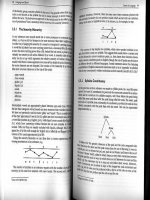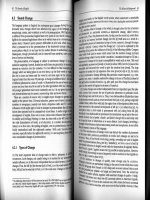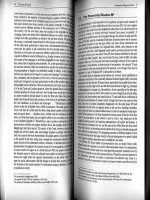Improving pronunciation of english by êđê learners oriented towards communication purposes
Bạn đang xem bản rút gọn của tài liệu. Xem và tải ngay bản đầy đủ của tài liệu tại đây (3.52 MB, 226 trang )
VIETNAM NATIONAL UNIVERSITY, HANOI
UNIVERSITY OF LANGUAGES AND INTERNATIONAL STUDIES
Y TRU ALIO
IMPROVING PRONUNCIATION OF ENGLISH
BY ÊĐÊ LEARNERS ORIENTED TOWARDS
COMMUNICATION PURPOSES
(CẢI THIỆN PHÁT ÂM TIẾNG ANH CỦA SINH VIÊN NGƯỜI
ÊĐÊ THEO ĐỊNH HƯỚNG MỤC ĐÍCH GIAO TIẾP)
Ph.D. DISSERTATION
Major: English Linguistics
Code: 62.22.15.01
Hà Nội, 2015
i
VIETNAM NATIONAL UNIVERSITY, HANOI
UNIVERSITY OF LANGUAGES AND INTERNATIONAL STUDIES
Y TRU ALIO
IMPROVING PRONUNCIATION OF ENGLISH
BY ÊĐÊ LEARNERS ORIENTED TOWARDS
COMMUNICATION PURPOSES
(CẢI THIỆN PHÁT ÂM TIẾNG ANH CỦA SINH VIÊN NGƯỜI
ÊĐÊ THEO ĐỊNH HƯỚNG MỤC ĐÍCH GIAO TIẾP)
Ph.D. DISSERTATION
Major: English Linguistics
Code: 62.22.15.01
Supervisors:
1. Assoc. Prof. Dr. Võ Đại Quang
2. Dr. Nguyễn Huy Kỷ
Hà Nội, 2015
ii
CERTIFICATE OF ORIGINALITY
I, the undersigned, hereby certify my authority of the study project report
entitled
IMPROVING PRONUNCIATION OF ENGLISH BY ÊĐÊ LEARNERS
ORIENTED TOWARDS COMMUNICATION PURPOSES
submitted in fulfillment of the requirements for the degree of Doctor of
Philosophy in English linguistics.
Except where the reference is indicated, no other person‟s work has been used
without due acknowledgement in the text of the dissertation.
Hanoi, 2015
Y Tru Alio
iii
ACKNOWLEDGEMENTS
This dissertation could not have been completed without the help and support from a
number of people.
First and foremost, I would like to express my sincere deepest gratitude to Assoc.
Prof. Dr. Võ Đại Quang, and Dr. Nguyễn Huy Kỷ, my supervisors, who have
patiently and constantly supported me through the stages of the study, and whose
stimulating ideas, expertise, and suggestions have inspired me greatly through my
growth as an academic researcher.
My special thanks go to Assoc. Prof. Dr. Lê Hùng Tiến, former Head of the
Postgraduate Studies Faculty, Dr. Huỳnh Anh Tuấn, Head of the Postgraduate
Studies Faculty and all the staff for their tremendous help with administrative
clearance, and many others, without whose support and encouragement it would
never have been possible for me to have this dissertation accomplished.
I am grateful to the University of Tây Nguyên where I have been working for the
best possible conditions from which I have benefited for the completion of the
dissertation.
Last but not least, I am greatly indebted to my family, my colleagues for the sacrifice
they have devoted to the fulfillment of this academic work.
iv
TABLE OF CONTENTS
CERTIFICATE OF ORIGINALITY ......................................................................................................................... I
ACKNOWLEDGEMENTS .................................................................................................................................IV
TABLE OF CONTENTS .....................................................................................................................................V
ABBREVIATIONS AND SYMBOLS ..................................................................................................................VII
LIST OF GRAPHS............................................................................................................................................ IX
LIST OF TABLES ............................................................................................................................................. IX
LIST OF SENTENCES ........................................................................................................................................ X
DEFINITIONS OF KEY TERMS ......................................................................................................................... XI
ABSTRACT .................................................................................................................................................. XIII
PART A. INTRODUCTION ............................................................................................................................... 1
1. RATIONALE FOR THE STUDY .................................................................................................................................1
2. AIM OF THE STUDY ............................................................................................................................................2
3. OBJECTIVES OF THE STUDY...................................................................................................................................2
4. RESEARCH QUESTIONS ........................................................................................................................................2
5. SCOPE OF THE STUDY .........................................................................................................................................2
6. SIGNIFICANCE OF THE STUDY ................................................................................................................................3
7. STRUCTURAL ORGANIZATION OF THE DISSERTATION..................................................................................................3
PART B. DEVELOPMENT ................................................................................................................................ 4
CHAPTER 1. LITERATURE REVIEW ................................................................................................................. 4
1.1. DEFINITION OF PRONUNCIATION........................................................................................................................4
1.2. DEFINITION OF LINKING AND ITS TYPES ................................................................................................................7
1.3. DEFINITION OF ASSIMILATION AND ITS TYPES ......................................................................................................10
1.4. PRONUNCIATION FROM THE PERSPECTIVE OF COMMUNICATIVE LANGUAGE TEACHING (CLT)....................................19
1.4.1. Pronunciation in CLT .......................................................................................................................19
1.4.2. Linking and assimilation instruction ..............................................................................................23
1.5. RESEARCH ON ÊĐÊ PRONUNCIATION ................................................................................................................36
1.6. SUMMARY ..................................................................................................................................................40
CHAPTER 2. METHODOLOGY ....................................................................................................................... 43
2.1. CONTRASTIVE ANALYSIS .................................................................................................................................43
2.2. ACTION RESEARCH ........................................................................................................................................45
2.2.1. Identifying the problems ................................................................................................................46
2.2.2. The treatment .................................................................................................................................46
2.2.2.1. Designing an intensive course................................................................................................................. 46
2.2.2.2. Conducting the teaching of the intensive course ................................................................................... 51
2.2.3. The progress ...................................................................................................................................53
2.2.4. Questionnaire for teachers’ attitude towards Êđê learners’ pronunciation ................................54
2.3. DATA COLLECTION ........................................................................................................................................54
2.3.1. The setting ......................................................................................................................................54
2.3.2. The participants ..............................................................................................................................55
2.3.2.1. Êđê learners............................................................................................................................................. 55
2.3.2.2. The volunteer teacher of English ............................................................................................................ 56
2.3.3. The procedure of the data collection .............................................................................................56
2.4. DATA ANALYSIS ............................................................................................................................................57
2.4.1. The descriptive and contrastive techniques...................................................................................57
2.4.2. The wave forms ..............................................................................................................................57
2.4.3. Tables and graphs ..........................................................................................................................61
2.4.4. Logical inferential statistics............................................................................................................61
2.5. SUMMARY ..................................................................................................................................................62
v
CHAPTER 3. FINDINGS AND DISCUSSION ..................................................................................................... 64
3.1. THE POTENTIAL CAUSES OF ÊĐÊ LEARNERS’ ERRORS IN PRODUCING ENGLISH SOUNDS ................................................64
3.1.1. The similarities between English vowels and Êđê vowels .............................................................66
3.1.2. The differences between English vowels and Êđê vowels .............................................................67
3.1.3. The similarities between English consonants and Êđê consonants ..............................................69
3.1.4. The differences between English consonants and Êđê consonants ..............................................70
3.1.5. The differences in consonant sequences ........................................................................................75
3.1.6. The differences between English syllable structures and Êđê syllable structures ........................81
3.1.7. The differences of sounds in connected speech of the two languages .........................................82
3.2. THE ÊĐÊ LEARNERS’ MISPRONUNCIATION OF ENGLISH RELATED TO LINKING AND ASSIMILATION ...................................84
3.2.1. Êđê learners’ mispronunciation of English linking ........................................................................84
3.2.2. Êđê learners’ mispronunciation of English assimilation .............................................................106
3.3. THE TREATMENT TO IMPROVE ÊĐÊ LEARNERS’ PRONUNCIATION OF ENGLISH LINKING AND ASSIMILATION.....................123
3.3.1. The treatment to improve the pronunciation of English linking .................................................124
3.3.1.1. Listening and imitating .......................................................................................................................... 125
3.3.1.2. Phonetic training ................................................................................................................................... 126
3.3.1.3. Minimal pair drills ................................................................................................................................. 129
3.3.1.4. Contextualized minimal pairs ............................................................................................................... 131
3.3.1.5. Visual aids .............................................................................................................................................. 132
3.3.2.The treatment to improve the pronunciation of English assimilation .........................................133
3.3.2.1. Listening and imitating .......................................................................................................................... 133
3.3.2.2. Phonetic training ................................................................................................................................... 133
3.3.2.3. Minimal pair drills ................................................................................................................................. 134
3.3.2.4. Contextualised minimal pairs ............................................................................................................... 135
3.3.2.5. Visual aids .............................................................................................................................................. 136
3.3.3. Pedagogical implication for English pronunciation teaching .....................................................136
3.4. TEACHERS’ ATTITUDE TOWARDS ÊĐÊ LEARNERS’ PRONUNCIATION OF ENGLISH .......................................................138
3.5. SUMMARY ................................................................................................................................................142
PART C: CONCLUSION ................................................................................................................................ 143
1. RECAPITULATION...........................................................................................................................................143
2.CONCLUDING REMARKS ...................................................................................................................................144
2.1.The cause of Êđê learners’ errors in producing English sounds ......................................................144
2.2. Êđê learners’ mispronunciation of English with respect to linking and assimilation ....................146
2.3. The treatment to improve Êđê learners’ English pronunciation ....................................................147
3. THE LIMITATION OF THE RESEARCH....................................................................................................................148
4. SUGGESTIONS FOR FURTHER STUDIES.................................................................................................................149
REFERENCES .............................................................................................................................................. 150
THE AUTHOR’S PUBLISHED ARTICLES AND PROJECTS RELATED TO THE DISSERTATION ............................. 153
APPENDICES ................................................................................................................................................... I
APPENDIX 1. THE CHART OF ENGLISH VOWELS AND CONSONANTS ................................................................................... I
APPENDIX 2. THE CHART OF ÊĐÊ VOWELS AND CONSONANTS ........................................................................................ II
APPENDIX 3 THE RESULTS OF PRONUNCIATION OF ENGLISH LINKING............................................................................... III
APPENDIX 4. THE RESULTS OF PRONUNCIATION OF ENGLISH ASSIMILATION ...................................................................... V
APPENDIX 5. THE MEAN, THE SD AND THE SE OF PRONUNCIATION OF ENGLISH LINKING ................................................... VII
APPENDIX 6. THE MEAN, THE SD AND THE SE OF PRONUNCIATION OF ENGLISH ASSIMILATION ............................................ IX
APPENDIX 7. KEYS TO THE TEST FOR PRONUNCIATION OF ENGLISH LINKING .................................................................... XII
APPENDIX 8. KEYS TO THE TEST FOR PRONUNCIATION OF ENGLISH ASSIMILATION.............................................................XIII
APPENDIX 9. INTENSIVE COURSE ON ENGLISH PRONUNCIATION .................................................................................. XIV
APPENDIX 10. LESSON PLANS ............................................................................................................................ XXVIII
APPENDIX 11. QUESTIONNAIRE FOR TEACHERS ........................................................................................................ LVII
APPENDIX 12. INFORMATION ABOUT THE DEVICES FOR RECORDING ...............................................................................LX
vi
ABBREVIATIONS AND SYMBOLS
1.
2.
3.
4.
5.
AlPlVAlPlV+
AlNV+
AlFrVAlFrV+
(Alveolar plosive voiceless)
(Alveolar plosive voiced)
(Alveolar nasal voiced)
(Alveolar fricative voiceless)
(Alveolar fricative voiced)
/C/
/D/
/Q/
/K/
/L/
6. AlFrV±
(Alveolar fricative voiced or voiceless)
/K±/
7. BilPlV8. BilPlV+
9. BilNV+
10. BilSV+
11. Conson.
12. DenFV13. DenFV+
14. LabDFrV15. LabDFrV+
16. LatV+
17. GlFrV18. PalAlAfV19. PalAlAfV+
20. PalV+
21. PostAlV+
22. PalAlFrV23. PalAlFrV+
24. VePlV+
25. VelPlV26. VelNV+
(Bilabial plosive voiceless)
(Bilabial plosive voiced)
(Bilabial nasal voiced)
(Bilabial semi-vowel voiced)
(Consonant)
(Dental fricative voiceless)
(Dental fricative voiced)
(Labial dental fricative voiceless)
(Labial dental fricative voiced)
(Lateral voiced)
(Glottal fricative voiceless)
(Palatal alveolar affricate voiceless)
(Palatal alveolar affricate voiced)
(Palatal voiced)
(Post-alveolar voiced)
(Palatal alveolar fricative voiceless)
(Palatal alveolar fricative voiced)
(Velar plosive voiced)
(Velar plosive voiceless)
(Velar nasal voiced)
/A/
/B/
/P/
/V/
27. V±
28. V
29. S
30. St
31. Sylcon
32. Sw
33. CLMT
34. GTM
33. L0
34. 1st
35. 2nd
36. SD1st
37. SD2nd
38. SE1st
Voiced or voiceless)
(Vowel)
(Sentence)
(Student)
(Syllabic consonant)
(Schwa)
(Communicative Language Teaching Method)
(Grammar Translation Method)
(Native speaker)
(The first mean)
(The second mean)
(The first standard deviation)
(The second standard deviation)
(The first standard error)
vii
/I/
/J/
/G/
/H/
/S/
/O/
/CM/
/DN/
/U/
/T/
/M/
/N/
/F/
/E/
/R/
39. SE2nd
40. SPE
41. /…/
42. […]
(The second standard error)
(The Sound Patterns of English)
(Slanting brackets used for phonemic transcriptions)
(Square brackets used for phonetic transcriptions)
viii
LIST OF GRAPHS
Graph 3.1: Scores obtained by 40 learners on linking ...….………………...............96
Graph 3.2: Scores obtained by 40 learners on assimilation…….….........................116
LIST OF TABLES
Table 3.1: The similarities between English vowels and Êđê vowels…..............…..64
Table 3.2: The differences between English vowels and Êđê vowels……….……..65
Table 3.3: The similarities between English consonants and Êđê consonants ….….67
Table 3.4: Consonants exist in English only and in Êđê only …..………….…..….69
Table 3.5: The differences between English and Êđê consonants in sequences ........73
Table 3.6: The differences in syllable structures …………………………….….....78
Table 3.7: The differences in sounds in connected speech ……….…….………….79
Table 3.8: Percentage of Êđê learners‟ scores on linking ………..............................96
Table 3.9: Percentage of Êđê learners‟ scores on assimilation ................................116
Table 3.10: Teachers‟ attitude towards Êđê learners‟ pronunciation ......................134
Table 3.11: The similarities and differences between English sounds and Êđê sounds
…………………………………………………………………….………………..141
ix
LIST OF SENTENCES
Sentences of linking
Sentence 3...................................................................................................................81
Sentence 8...................................................................................................................84
Sentence 21.................................................................................................................85
Sentence 28.................................................................................................................87
Sentence 35a...............................................................................................................88
Sentence 39.................................................................................................................89
Sentence 46.................................................................................................................90
Sentence 60.................................................................................................................91
Sentence 108...............................................................................................................93
Sentence 144...............................................................................................................94
Sentences of assimilation
Sentence 18...............................................................................................................102
Sentence 35b.............................................................................................................104
Sentence 52...............................................................................................................105
Sentence 72...............................................................................................................106
Sentence 79...............................................................................................................107
Sentence 121…………………………………………………………………….…108
Sentence 126…………………………………………………………………….…110
Sentence 128……………………………………………………………………….111
Sentence 151……………………………………………………………………….113
Sentence 190……………………………………………………………………….114
x
DEFINITIONS OF KEY TERMS
The following cues have been used in this dissertation to convey the information
presented.
(1) The italic type is used for the emphasized sounds, words, phrases or sentences
which are defined in the text.
(2) The mean () is the average of a set of scores (obtained by adding the
individual scores together and dividing by the total number of scores). The mean
gives us information about the central tendency of the scores.
(3) The standard deviation (SD) is the most important measure of dispersion. The
standard deviation can be estimated by deducting the mean from each individual
score, squaring the resulting figures to get rid of the minus signs, adding these
together and dividing by the number of scores minus one. This gives the variance.
The SD gives information on the extent to which a set of scores varies in relation to
the mean.
(4) The standard error (SE) equals the standard deviation divided by the square
root of the number. The standard error‟s information can be used to place a single
sample mean in relation to the population mean from which it is drawn.
(5) Frequency is measured in Hertz (Hz), to be referred to the frequency of
vibration of the vocal cords.
(6) The amplitudes can be known as the waveform. The average amplitude of the
waveform over a small fraction of a second is a convenient way of presenting the
amplitude at that point. The computerized Speech Lab (CSL) Model 4500 calculates
amplitude graph, and is called amplitude.
Note: The information gained from the wave forms when being observed is still very
abstract, since the observations involve the frequency calculations (times, intensities,
and frequencies). There are still lists of questions and problems that might be needed
for further future works. However, in the dissertation, the wave forms are used to
illustrate and to compare the differences between native speakers‟ voices recorded
and Êđê learners‟ voices recorded.
xi
(7) Transcriptions
In this present study, slanting squares / / are used for phonetic transcriptions and
bracket squares [ ] for phonological transcriptions. Some sounds are tested within
words, and some words are tested in contexts. Some sentences are not needed to be
transcribed in the whole utterance. The transcriptions, depending on the items to be
tested for the study purpose, can be in the full sentence at once or only in a few
words of the sentence.
xii
ABSTRACT
This is a study of improving pronunciation of English with respect to linking and
assimilation for Êđê learners.
This study attempts to achieve three objectives that are (i) identifying the potential
causes of Êđê learners‟ errors in producing English sounds; (ii) identifying the
problems of English mispronunciation related to linking and assimilation made by
Êđê learners (iii) working out the treatment to improve English pronunciation for Êđê
learners.
The main issues in the present study are dealt with the following research questions:
(i) What are the potential causes of Êđê learners‟ pronunciation from a contrastive
perspective? (ii) What are the English pronunciation problems encountered by Êđê
learners with respect to linking and assimilation? (iii) To what extent does the
application of pronunciation improvement techniques affect Êđê learners‟
pronunciation with regards to linking and assimilation?
In order to find out the answer to the research questions, this study employs
contrastive analysis for identifying the similarities and differences between English
sounds and Êđê sounds, and action research with three steps: (i) identifying the
English pronunciation problems encountered by Êđê learners; (ii) the treatment:
designing an intensive course of English pronunciation, conducting the teaching of
the intensive course, recording Êđê learners pronunciation; (iii) the progress:
comparing the results of the recordings.
The findings of the present study are concerned with the differences between English
sounds and Êđê sounds that are thought to be the potential causes of Êđê learners‟
errors in producing English sounds. By the application of the intensive course of
English pronunciation and the appropriate teaching techniques, Êđê learners
pronunciation has improved significantly.
xiii
PART A. INTRODUCTION
This part states the rationale for the study, the aim and objectives of the study, the
scope and significance of the study, and the structural organization of the
dissertation.
1. Rationale for the study
For Êđê learners who study English as a foreign language, English pronunciation
plays an important role in acquiring it. To have a good English pronunciation sooner
or later, Êđê learners should have knowledge of English pronunciation in particular
and English phonetics and phonology in general. Since the English language has its
own phonological rules, spelling and pronunciation of English are practically two
different things, Êđê learners should learn the pronunciation of the sounds in
connected speech of English receptively and productively, they should be able to
understand what they hear in English, and should not damage what they say, should
overcome their reluctance to use English. The pronunciation of English is required at
any proficient levels of English, and it is considered as manifestation of the
realization of learners‟ understanding of how English sounds activate in the reality of
spoken English.
The English language borrows the Roman alphabet, so does the Êđê language.
However, in each language the sound values, to some extent, are different, especially
English sounds in connected speech. English sounds produced by Êđê learners tend
to be unnatural, erroneous in some cases, and tend to make incomplete plosion in
producing word endings. For example, Êđê learners produce erroneously the words
ending in „-ed‟, „-s‟, „-z‟ with their linking such as in “stripped of everything”, “My
parents are at a meeting and my sisters are at the cinema” (Mortimer, 1985). Their
incorrect pronunciation of English may lead to mislinking in connected speech, or
misunderstanding, or ungrammatical and unnatural pronunciation.
Having been teaching English at Tây Nguyên University, I realize that Êđê learners
have difficulties in the pronunciation of English. Together with the sounds of
English, the aspects of connected speech are also the problems that emerge in their
1
pronunciation. In addition, there have been a number of studies related to English
pronunciation for learners of different countries, but not for Êđê learners, a group of
ethnic minorities in Vietnam. On the account of these, I have got a strong belief in
solving the identified aspects of English pronunciation made by Êđê learners, and as
a teacher of English, I realize that there is a need to improve their pronunciation of
English towards communication purposes. So an investigation into improving
English pronunciation of linking and assimilation is necessary, and my decision on
choosing the theme for my study is based on this belief.
2. Aim of the study
The overall purpose of the study is to improve English pronunciation produced by
Êđê learners with the focus on English linking and assimilation.
3. Objectives of the study
This study is an attempt:
- to identify the potential causes of Êđê learners‟ errors in producing English
sounds;
- to identify the problems of English mispronunciation related to linking and
assimilation made by Êđê learners;
- to work out the treatment to improve English pronunciation for Êđê learners.
4. Research questions
(1) What are the potential causes of Êđê learners‟ pronunciation from a contrastive
analysis perspective?
(2) What are the English pronunciation problems encountered by Êđê learners
with respect to linking and assimilation?
(3) To what extent does the application of pronunciation improvement techniques
affect the students‟ pronunciation with regard to linking and assimilation?
5. Scope of the study
The study is defined to the problems of English pronunciation encountered by Êđê
learners at Tây Nguyên University with respect to linking and assimilation of
English.
2
6. Significance of the study
This study, to my knowledge, is the first systematic research on the similarities and
differences between English sounds and Êđê sounds; the first research on the
problems of English pronunciation encountered by Êđê learners due to the
differences between the two languages; and the first research on the solutions for the
improvement of English pronunciation for Êđê learners at Tây Nguyên University.
From the theoretical perspective
This study is significant for both Êđê learners of English and Vietnamese teachers of
English in the awarness of the differences between sounds of the two languages. The
identifying of the similarities and differences between the English and Êđê sounds
contributes to consolidating the strength and power of the theoretical points initiated
and developed by the authorities in the field of phonetics and phonology.
From the practical perspective
The pedagogical implication of selected teaching techniques for pronunciation of
English in the classroom is given by the present study. Êđê learners will be helped to
improve their pronunciation of English linking and assimilation.
7. Structural organization of the dissertation
This dissertation consists of three parts. Part A is the introduction that presents the
rationale for the study, the aim, the objectives, the research questions, the scope and
the significance of the study. Part B is the development with its three chapters:
chapter 1 presents the literature review; chapter 2 states the methodology, and
chapter 3 gives the findings and discussion. Part C is the conclusion that provides the
recapitulation, concluding remarks on each of the three research objectives,
recommendations for pedagogically implicating the achieved results of the research,
suggestions for further studies. The information about the referred research for the
dissertation is stated in the references after Part C. The details for the data of the
study are presented in the appendices that end the dissertation.
3
PART B. DEVELOPMENT
CHAPTER 1. LITERATURE REVIEW
The literature review presents the theoretical background related to the definition of
English pronunciation, pronunciation from the communication view and from the
teaching view, the research on English pronunciation with the focus on linking and
assimilation, and the research on Êđê pronunciation.
1.1. Definition of pronunciation
So far, there have been a number of research on the English pronunciation which
serve as the ground for the study review. These works are: Teaching Pronunciation,
a reference for teachers of English to speakers of other languages, compiled by
Celce-Murcia et al. (1996); An Introduction to the Pronunciation of English that has
been written by Gimson (1962); English Phonetics and Phonology that is
researched by Roach (1988); Gimson‟s Pronunciation, done by Cruttenden (2001);
Applied English Phonology written by Yavas (2006); Phonology in English
Language Teaching worked by Pennington (1996); Teaching Pronunciation,
researched by Celce-Murcia, et al. (1996); How to Teach Pronunciation, done by
Kelly (2000); Teaching English Pronunciation, studied by Kenworthy (1998), etc.
Their contributions have been made relating to the English sounds and aspects of
connected speech. These works are understandable and become guide-principles
governing rules of pronunciation of English in the following parts of the study
conveying linking and assimilation of English as Underhill (1994: 58) points out:
“Connected speech is not just the sum of its individual words. Continuous
connected speech consists of a flow of sounds which are modified by a system
of simplifications through which phonemes are connected, grouped and
modified. Stream of speech pronunciation brings together the three branches of
practical phonology: sounds, stress and intonation” (Underhill, 1994: 58).
In English, there is not a one-to-one correspondence between spelling and
pronunciation, but between sounds and letters. Many letters can represent more than
one sound. The relationship between spelling and pronunciation is not always easy
4
for those who learn English as a foreign language to see how a written English word
should be pronounced and how a word they have heard should be written.
By improving pronunciation of English we mean to help Êđê learners to pronounce
English well enough to be understood when they speak, to be able to perform what
they want to say. In terms of pronunciation of English towards communication, as
Ramsey et al. (1989) emphasise “fluency rather than accuracy”, Êđê learners are
expected to pronounce English sounds with an awareness of appropriate
phonological rules of linking and assimilation, and as Mortimer (1985) suggests
learners should “make sure that the overall pronunciation sounds natural”.
There are many views related to pronunciation such as pronunciation and spelling,
pronunciation of individual sounds of English (vowels and consonants),
pronunciation of sounds in connected speech (ending sounds, contraction, linking,
assimilation, stressed and unstressed syllables, weak forms, rhythm, word stress,
and intonation). The present study focuses on pronunciation of English sounds in
connected speech related to linking and assimilation. Linking and assimilation
means sound relations within words and sound relations between words, i.e. sounds
across the word boundary. The theoretical backgrounds for the study on the
pronunciation of English are regarded from the theories provided by Katamba
(1996), Avery & Ehrlich (1998), Dalton & Seidlhofer (1995), Pennington (1996),
Spencer (1996), and Tatham et al. (2006).
Pronunciation of English should be an integral part of an English classroom
conducted together with other language skills by the teachers from the early stages.
It is obvious that sounds in connected speech of English have their own phonetic
and phonological characteristics. Pronunciation not only relates to correct
articulation but also concerns with the meanings from an utterance. As Dalton &
Seidlhofer (1995) claim that “pronunciation is never an end in itself but a means to
negotiate meaning in discourse.” Dalton & Seidlhofer (1995: ix) insist that “while
teacher education may require an understanding of pronunciation as an aspect of the
5
language system, it will often be preferable in teaching to proceed according to
priorities determined by how pronunciation functions in language use”.
The selected aspects for the study on pronunciation of linking and assimilation have
two reasons: (i) the English pronunciation is conceptualized as actual sounds of
English in spoken forms; and (ii) at the beginning of English learning, the
pronunciation towards communication starts with the basic phonetic and
phonological pronunciation. Since pronunciation of English is important not only to
Êđê learners for the purpose of understanding and being understood, but also to
those who learn English with the problems of English sounds in connected speech
as Rogerson & Gibert (1993:1) state:
“Sometimes „communication breakdown‟ is due to a grammar or vocabulary
mistakes and sometimes it is due to a pronunciation mistake. Just as you need
to be able to analyse and correct your grammar and vocabulary mistakes you
need to be able to analyse and correct your pronunciation mistakes. It is not
necessary to pronounce every sound perfectly to be understood – only a few
parts of each sentence are really important, but these parts are essential. The
native speaker depends on hearing these parts clearly, therefore you need to
know which parts of a sentence must be clear and how to make them clear”
(Rogerson & Gilbert, 1993: 1).
From the view of teaching and learning English, pronunciation means, to a certain
extent, to function English sounds in spoken forms, to speak so that people listen to
what we say and then join the way we say, so that the meaning we intend is clear, to
produce appropriate sounds and sound patterns, and to be confident to speak
English. There is a bunch of definitions of pronunciation of English initiated by the
authorities with language teaching methods which are adopted as means to satisfy
their ends.
The growth in the use of English means that English is used as a medium of
communication between nations of the world, and it is used as a global language.
Dalton & Seidlhofer (1995: 3) define pronunciation in general terms as the
production of significant sound in two senses. First, sound is significant because it
is used as part of a code of a particular language. In this sense, pronunciation is as
the production and reception of sounds of speech. Second, sound is significant
because it is used to achieve meaning in contexts of use. Here the code combines
6
with other factors to make communication possible. In this sense, pronunciation is
with reference to acts of speaking.
Though considering pronunciation in both senses, Dalton & Seidlhofer (1995) give
particular prominence to communicative aspects, and refer to the physical features
of sounds only in so far as they are relevant to an understanding of how they figure
in discourse, that is to say in the achievement of meaning. According to Dalton &
Seidlhofer (1995), the significance of pronunciation lies in general points about the
role of pronunciation in social interaction.
Traditionally, according to Celce-Murcia et al. (1996: 291), pronunciation has been
defined as the accurate production of the sounds, rhythms, and intonation patterns
of a language. Pronunciation itself plays an important part in communicative
language teaching. The teaching of pronunciation means the teaching of a spoken
language meeting the demand of learner‟s communication compared with the target
language as Pennington (1996:2) regards:
“Pronunciation is also a primary medium for communication of information
about ourselves as individuals and as representatives of different groups. Since
it opens the way to a better understanding of how language works and how the
different aspects of linguistic and social meaning are interrelated, an
understanding of the phonology of a language is a necessary basis for fully
effective teaching of a spoken language” (Pennington, 1996:2).
Recently, as Jenkins (2000) states, pronunciation is taken into the new century with
a perspective relevant to the needs of the world‟s majority of English speakers.
1.2. Definition of linking and its types
According to Avery & Ehrlich (1998: 84) “in connected speech, words within the
same phrase or sentence often blend together. Connecting groups of words together
is referred to as linking. When words are properly linked, there is a smooth
transition from one word to the next.” Consider the link of consonants to vowels for
illustration:
7
- C(labial) + V: stop it , grab it, came in;
- C(dental) + V: with it, breath it;
- C(alveolar) + V: washed it, run around;
- C(palatal) + V: march in, cash out;
C(velar) + V: back out, sing it
(Avery & Ehrlich (1998: 84)
According to Celce-Murcia et al. (1996), the amount of linking is not entirely
preditable, but linking occurs with regularity in the following five environments:
(1) Linking with a glide commonly occurs when one word or syllable ends in a
tense vowel or diphthong and the next word or syllable begins with a vowel: be
able.
(2) When a word or syllable ending in a single consonant is followed by a word
or syllable beginning with a vowel, the consonant is often produced intervocalically
as if it belonged to both syllables: dog eat dog.
(3) When a word or syllable terminating in a consonant cluster is followed by a
word or syllable commencing with a vowel, the final consonant of the cluster is
often pronounced as part of the following syllable: left arm, find out.
(4) When two identical consonants come together as a result of the juxtaposition
of two words, there is one single, elongated articulation of the consonant (i.e.,
native speakers do not produce the consonant sound twice): short time, big gap.
(5) When a stop consonant is followed by another stop or by an affricate, the
first stop is not released, which facilitates the linking: blackboard, good jury, big
dipper. (Celce-Murcia et al., 1996: 158-59).
In this part, linking can be classified into the following types: the linking of vowelto-vowel (V-V), consonant-to-vowel (C-V), and consonant-to-consonant (C-C). By
linking, English people are said not to do a pause between each word when
speaking, but move smoothly from one word to the following words or sounds. In
such cases, sounds often happen in groups, phrases or sentences, i.e. linkage of
English sounds often occurs in connected speech and in natural speech.
8
Phonologically, English sounds in contexts may spread their characteristics to the
next other sounds, i.e. the pronunciation of sounds in the combination of other
sounds stretching accordingly with the movement of organs of speech that is on the
way to reach the next sounds in the continuum speech. Together with the
differences in the place of articulation, at the same time, sounds to be produced will
change their manner of articulation.
(6)
The effect of linguistic context on pronunciation is, as Pennington (1996: 26-7)
explains, as follows:
“The strictly linguistic context of neighboring sounds influences the
pronunciation of given segment or stretch of speech. In connected speech,
sounds are coarticulated to a greater or lesser degree. Coarticulation means
that the one sound, rather than being produced entirely distinctly from other
sounds with which it occurs tends to blend imperceptibly into the next”
(Pennington, 1996: 26-7).
There exist many phonological processes such as elision, deletion, linking,
assimilation to make the pronunciation fluent and smooth. Dalton & Seidlhofer
(1995: 123) states that “linking is more specific: it applies only to what happens at
word-boundaries where either two vowels or a consonant and a vowel meet”.
In relation to the way English sounds are produced, phonologically, the writer finds
that the final sounds of a word might release their phonetic and phonological
characteristics stretching across sounds in connected speech that can be a linkage of
preceding sounds to the sound of the following words. Moreover, English words in
connected speech are not produced in isolation, but they are produced with a link.
The phenomenon of linking of English occurs when the final sound of one word
affects the initial sound of the following word. Linking of English often happens
across word boundaries.
In the present study, besides the ending sounds of individual words of English, the
writer also refers to what ending sounds of words leave off in continuous speech
stream, i.e. the ending sounds of preceding words will spread and stretch its
phonetic and phonological features to the next sounds in connected speech.
(7)
(8)
9
(9)
In connected speech, English speakers sometimes link words together. The most
familiar case of linking is when a word ends with a consonant and the next word
begins with a vowel, and when a word ends in a vowel and the next word begins
with a vowel. For instance, the difference between „my turn‟ /Pa" C*:Q/ and
„might earn‟ /Pa"C *:Q/ is that in the case of “my turn”, the /C/ in „turn‟ is
aspirated, and in the case of „might earn‟, the /C/ in „might‟ is not aspirated (Roach,
1988: 110). The difference between aspirated and unaspirated /C/ may cause a
difference in meaning as well as in grammar. In another cases of linking, sounds are
attracted across word boundaries, such as “more ice” and “more rice”, “the great
apes” and “the grey tapes” (Kelly, 2000: 112). Roach (1988) insists that learners of
English must be clearly aware of the problems that they will meet in listening to
colloquial and connected speech.
In brief, the understanding of the basic possible combinations of sounds in final
positions of preceding words with sounds in initial positions of following words
will help Êđê learners to become aware of pronunciation of English linking.
1.3. Definition of assimilation and its types
By assimilation, Celce-Murcia et al. (1996) mean that an adjustment in connected
speech is the process of assimilation, during which a given sound takes on the
feature of a neighboring sound. Assimilation occurs frequently in English, either
within words or between words. There are three types of assimilation:
(1) Progressive assimilation, for example, bags, and backs, „s‟ of bags is
assimilated, it changes to become voiced /L/, and „s‟ of backs is assimilated, it
changes to become voiceless /K/;
(2) Regressive assimilation, for example, have to, „v‟ of have is assimilated, it
changes to become /G/, another examples, used to, „-ed‟ of used is pronounced as
/D/, but in this case it is assimilated and changes to become voiceless /C/; He‟s in
10
pain, „n‟ of in is assimilated by a plosive bilabial /A/ that follows it, in this case „n‟
changes to /P/.
(3) Coalescent assimilation, for example, „Is that your dog?”, /C/ of that + /U/
of your come together and create a third sound with features from both original
sounds. /C/ + /U/ become /CM/.
(Celce-Murcia et al., 1996).
Pennington (1996) considers coarticulation as the effect of linguistic context on
pronunciation, Spencer (1996) considers coarticulation as phonological process and
postlexical process in English. Katamba (1996) explores that in the production of
speech, due to adjustment of the articulatory apparatus in the transition from one
sound to the next, phonetic properties may spread their distinctive features in their
environment; this phonological process leads to allophones and assimilation, and
the phonological behaviour of phonemes is largely determined by the phonetic
features, as Katamba (1996) points out:
“In language a phoneme has several allophones, with the allophone selected in
a particular position being dependent on the other sounds that are adjacent to
it. The commonest phonological process responsible for this is assimilation.
Assimilation is the modification of a sound in order to make it more similar to
some other sound in its neighborhood. The advantage of having assimilation is
that it results in smoother, more effortless, more economical transitions from
one sound to another. It facilitates the task of speaking. The speaker usually
tries to conserve energy by using no more effort that it is necessary to produce
an utterance” (Katamba, 1996: 80-1).
In an utterance, Roach (1988: 106) points out that speech sounds often occur one
after another, therefore they are produced with the movement of organs of speech in
contacting with each other to reach the next sounds. The movement sometimes
cannot reach completely the ideal position of the sounds to be pronounced. For
example in “that side”, in rapid speech, /t/ of „that‟ is produced as /s/ because the
following sound in „side‟ starts with /s/, therefore the organs of speech should be
ready to move to reach the next sound. This phenomenon in phonology has been
said to be coarticulation or assimilation.
11
Stating phonological rules that divert the realization of lexical sounds in certain
directions before the phonetic realization, Roca & Johnson (1999: 48) divide these
rules into lexical levels and phonetic levels. Consider the examples of the lexical
level in cup; and the phonetic level in cupful. At the lexical level, [p] in cup is the
bilabial stop; at the phonetic level, [p] in cupful is a labiodental when standing
before [f],. As a result, they conclude that the phonetic realization will come out of
the mouth that will accordingly correspond to the form modified by the rule rather
than its lexical base.
According to Roca & Johnson (1999) phonological rules “are as much part of the
machinery of the sound component of language as are lexical representations.” In
particular, learners must learn the rules of a language if they are ever going to get its
pronunciation right, because the differences in pronunciation between different
languages or accents within the same language are the result of the presence of
different rules in those languages.
Roca & Johnson (1999: 54) differentiate phonetics from phonology as follows:
“phonetics describes sounds: articulatorily (positions and movements of the speech
organs), acoustically (patterns in the air, detectable with the appropriate technology)
and perceptually (impact of the sound on the ear and subsequent transmission of the
signal to the brain); and phonology will be aimed at its more abstract aspects.”
The combination of the feature of phonemes as mentioned above: the phoneme /p/
in cup is described as fortis, voiceless, bilabial and oral stop. In contextual aspect as
in the word cup-ful or cup final, the phoneme /p/ can be realized as a labio-dental
stop. In English there is a complication in both phonemic system and its phonetic
realization that Gimson (1962: 50) summarizes as follows:
-
different coexistent phonemic system;
-
phonetic discrepancies in the realization of the phonemes;
-
variation in the distribution of phonemes in words, even within a community
using the same phonemic system;
12



